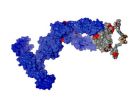(Press-News.org) Lincoln, Neb., May 15, 2014 -- In many rural communities hard hit by decades of population declines, young men increasingly outnumber young women, a new study of Kansas and Nebraska census data shows.
In places with 800 or fewer residents, the proportion of young men increased by an average of nearly 40 percent as people went from their teens to their 20s.
Those findings suggest leaders should consider the needs of young women in their economic and community development plans, said Robert Shepard, a University of Nebraska-Lincoln doctoral candidate who conducted the peer-reviewed research. His study results were published in April's Great Plains Research journal.
"The whole point of this study was to look at it quantitatively, to see if the numbers bear out this story of younger people leaving and not coming back," he said. "My study was important in helping to substantiate that this is a problem associated with gender."
Examining census data from 2000 and 2010, Shepard found that more than half of 1,627 villages, rural townships, precincts and other locales with 800 or fewer people experienced an increased ratio of young men to young women.
The median increase was just under 7 percent, but many of the smallest communities saw extreme increases – in excess of 200 percent -- in the proportion of males to females.
Shepard said he wanted to learn whether young women were staying in rural areas or returning home after college at the same rates as young men.
"There is a lot of awareness that younger people are leaving rural communities," Shepard said. "Where some of the men can come back, because there are a lot of traditionally male jobs like agriculture and industry to return to, many rural communities don't often provide the same opportunity to women. As long as that imbalance is there, it's going to limit the development or growth of that age group."
He found no previous research that evaluated migration patterns of his target group, young adults who would be starting families. Public U.S. Census data doesn't reveal the whereabouts of living individuals, making difficult to track such patterns.
Shepard chose a snapshot approach. He used the 2000 census to calculate the ratio of boys to girls aged 12 to 17 in more than 2,200 Nebraska and Kansas cities, towns and townships. He compared that figure to the ratio of men to women aged 22 to 27 in the 2010 census.
He chose those age ranges to establish a roughly high-school-aged population cohort in 2000 and to take a second look at it in 2010 – a time span allowing for completion of college and establishing a household.
Shepherd found a growing proportion of young women in urban areas during the post-college years. Major cities and suburbs, including Omaha and Kansas City, Kan., had nearly equal ratios of males and females in the 22-to-27 age group. In several others, including Topeka, Kan., and Scottsbluff, Neb., women outnumbered men in their age group.
College may be a significant reason why many young women leave rural communities, Shepard said. As of 2000, women comprised 56 percent of 25- to 29-year-olds with at least four years of higher education. Social and economic reasons often prevent college graduates from returning home – they may have formed bonds with new people or the rural job market may be unfavorable.
Shepard said more research is needed to investigate why young women migrate away from rural areas. In previous studies exploring women's attitudes toward the rural Great Plains, some women reported limited job opportunities, while others described a patriarchal culture in some rural communities. No previous research explicitly addressed how rural population change relates to gender, he said.
When he plotted sex ratio changes from 2000 to 2010 on a map, Shepard said he was surprised to find more of a patchwork than a clear urban-rural pattern. Some places that saw significant increases in the proportion of males bordered places that saw equally significant increases in the number of women. He called for more research into why some areas seem more attractive to women than others.
Another surprise was that in some communities, young men left in greater numbers than young women – but the ratio of males to females still increased. That's because the number of women in that community already was small. Blaine township in Clay County, Kan., for example, lost 11 of 19 males and 9 of 11 females from 2000 to 2010. Its ratio of males to females in the cohort changed from less than two men for every woman to four men for every woman.
"The big implication here is that if these ratios don't trend back toward equilibrium, there is some concern about the long-term population stability of those areas," he said.
INFORMATION:
Study shows young men increasingly outnumber young women in rural Great Plains
In Kansas and Nebraska rural communities, the ratio of young men to young women increased from 2000 to 2010
2014-05-15
ELSE PRESS RELEASES FROM THIS DATE:
Most NHL players peak by age 29: Study
2014-05-15
A new University of British Columbia study identifies when the clock runs out on an NHL player's peak performance, giving team executives insight into how best to build a roster.
The study by Sauder School of Business professor James Brander found that the performance of forwards peaks between the ages of 27 and 28. Defencemen are best between 28 and 29, and the performance of goaltenders varies little by age.
The forthcoming study to be published in the Journal of Quantitative Analysis in Sports also reveals that players performed close to their peak levels for a ...
Learning from sharks
2014-05-15
This news release is available in German.
Custom-tailored antibodies are regarded as promising weapons against a multitude of serious illnesses. Since they can accurately recognize specific structures on the surface of viruses, bacteria or cancer cells, they are already being deployed successfully in cancer diagnostics and therapy, as well as against numerous other diseases. The stability of the sensitive antibodies is a decisive factor in every step, from production and storage to therapeutic application.
A team of researchers headed by Dr. Matthias J. Feige and ...
Where have all the mitochondria gone?
2014-05-15
It's common knowledge that all organisms inherit their mitochondria – the cell's "power plants" – from their mothers. But what happens to all the father's mitochondria? Surprisingly, how – and why – paternal mitochondria are prevented from getting passed on to their offspring after fertilization is still shrouded in mystery; the only thing that's certain is that there must be a compelling reason, seeing as this phenomenon has been conserved throughout evolution.
Now, Dr. Eli Arama and a team in the Weizmann Institute's Molecular Genetics Department have discovered special ...
Sugar implicated in cardiovascular disease risk independent of weight gain
2014-05-15
Researchers from New Zealand's University of Otago have uncovered evidence that sugar has a direct effect on risk factors for heart disease, and is likely to impact on blood pressure, independent of weight gain.
Research Fellow with Otago's Department of Human Nutrition Dr Lisa Te Morenga, Professor Jim Mann and colleagues have conducted a review and meta-analysis of all international studies that compared the effects of higher versus lower added sugar consumption on blood pressure and lipids (blood fats or cholesterol) – both of which are important cardiovascular risk-factors.
They ...
This is your brain on meditation
2014-05-15
Mindfulness. Zen. Acem. Meditation drumming. Chakra. Buddhist and transcendental meditation. There are countless ways of meditating, but the purpose behind them all remains basically the same: more peace, less stress, better concentration, greater self-awareness and better processing of thoughts and feelings.
But which of these techniques should a poor stressed-out wretch choose? What does the research say? Very little – at least until now.
A team of researchers at the Norwegian University of Science and Technology (NTNU), the University of Oslo and the University ...
HIV patient nutrition more vital than once assumed
2014-05-15
Roughly 25 million Africans live with HIV, many of who now have access to antiretroviral drugs (ARVs). Among their side effects, ARVs can cause patients to put on weight. Subsequently, attention paid to malnutrition among African HIV patients has waned. However, widespread malnutrition has been identified as a reason that up to a quarter of HIV patients in a number of African countries die just months after beginning medical treatment.
A collaborative project between the University of Copenhagen and Jimma University, Ethiopia has demonstrated that daily nutritional supplementation ...
The state of rain
2014-05-15
Using modern weather satellites to monitor rainfall has become a robust, widely practiced technique. However, establishing a reliable context for relating space-based rainfall observations to current and historical ground-based rainfall data has been difficult.
A new dataset developed in partnership between UC Santa Barbara and the U.S. Geological Survey (USGS) can be used for environmental monitoring and drought early warning. The Climate Hazards Group Infrared Precipitation with Stations (CHIRPS), a collaboration between UCSB's Climate Hazards Group and USGS's Earth ...
Study finds hazardous flame retardants in preschools
2014-05-15
Berkeley — A new study of preschools and day care centers finds that flame retardants are prevalent indoors, potentially exposing young children to chemicals known to be hazardous.
The study, to appear online Thursday, May 15, in the journal Chemosphere, was led by researchers at the University of California, Berkeley, and funded by the California Air Resources Board. Although many infants and young children spend up to 50 hours per week in day care, the study authors noted that this paper represents the first systematic review of flame retardants in early child care ...
West Antarctic Ice Sheet collapse is under way
2014-05-15
The West Antarctic Ice Sheet, which holds enough water to raise global seas by several feet, is thinning. Scientists have been warning of its collapse, based on theories, but with few firm predictions or timelines.
University of Washington researchers used detailed topography maps and computer modeling to show that the collapse appears to have already begun. The fast-moving Thwaites Glacier will likely disappear in a matter of centuries, researchers say, raising sea level by nearly 2 feet. That glacier also acts as a linchpin on the rest of the ice sheet, which contains ...
Phase I data suggest PLX3397 is a potential therapy for patients with advanced PVNS
2014-05-15
NEW YORK, NY, May 14, 2014 — A novel targeted drug shows promise in treating patients with advanced pigmented villonodular synovitis (PVNS), a rare neoplastic joint disorder, according to new phase I data from Memorial Sloan Kettering Cancer Center and other institutions highlighted to media today in advance of the 50th Annual Meeting of the American Society of Clinical Oncology (ASCO), which will take place from May 30 to June 3 in Chicago.
At the time of interim analysis, 11 of 14 evaluable patients (79 percent) had a partial response to the drug and three patients ...
LAST 30 PRESS RELEASES:
Numbers in our sights affect how we perceive space
SIMJ announces global collaborative book project in commemoration of its 75th anniversary
Air pollution exposure and birth weight
Obstructive sleep apnea risk and mental health conditions among older adults
How talking slows eye movements behind the wheel
The Ceramic Society of Japan’s Oxoate Ceramics Research Association launches new international book project
Heart-brain connection: international study reveals the role of the vagus nerve in keeping the heart young
Researchers identify Rb1 as a predictive biomarker for a new therapeutic strategy in some breast cancers
Survey reveals ethical gaps slowing AI adoption in pediatric surgery
Stimulant ADHD medications work differently than thought
AI overestimates how smart people are, according to HSE economists
HSE researchers create genome-wide map of quadruplexes
Scientists boost cell "powerhouses" to burn more calories
Automatic label checking: The missing step in making reliable medical AI
Low daily alcohol intake linked to 50% heightened mouth cancer risk in India
American Meteorological Society announces Rick Spinrad as 2026 President-Elect
Biomass-based carbon capture spotlighted in newly released global climate webinar recording
Illuminating invisible nano pollutants: advanced bioimaging tracks the full journey of emerging nanoscale contaminants in living systems
How does age affect recovery from spinal cord injury?
Novel AI tool offers prognosis for patients with head and neck cancer
Fathers’ microplastic exposure tied to their children’s metabolic problems
Research validates laboratory model for studying high-grade serous ovarian cancer
SIR 2026 delivers transformative breakthroughs in minimally invasive medicine to improve patient care
Stem Cell Reports most downloaded papers of 2025 highlight the breadth and impact of stem cell research
Oxford-led study estimates NHS spends around 3% of its primary and secondary care budget on the health impacts of heat and cold in England
A researcher’s long quest leads to a smart composite breakthrough
Urban wild bees act as “microbial sensors” of city health.
New study finds where you live affects recovery after a hip fracture
Forecasting the impact of fully automated vehicle adoption on US road traffic injuries
Alcohol-related hospitalizations from 2016 to 2022
[Press-News.org] Study shows young men increasingly outnumber young women in rural Great PlainsIn Kansas and Nebraska rural communities, the ratio of young men to young women increased from 2000 to 2010




